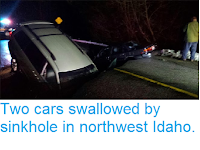The United States Geological Survey
recorded a Magnitude 5.3 Earthquake at a depth of 9.2 km about 17 km to
the east of Soda Springs in Caribou County, Idaho, slightly after 11.40 am
local time (slightly after 5.40 pm GMT) on Sunday 3 September 2017.
There are no reports of any serious damage or injuries associated with
this event, but it was felt across much of Idaho as well as parts of Montana, Wyoming, Utah and Oregon.
The approximate location of the 3 September 2017 Idaho Earthquake. USGS.
The quake took place close to the Yellowstone Magma Chamber in the
northeast of Wyoming, an area that suffers more-or-less constant small
tremors due to the movement of magma beneath the surface, but which
seldom experiences larger quakes. The constant small movements around
Yellowstone can lead to stress building up in rocks further away,
leading to Earthquakes as the rocks release the strain by readjusting
their positions, which can affect Wyoming as well as neighbouring Idaho
and Montana. The same faults also suffer stress due to more distant rock
movements, notably on the subduction zone on the American west coast.
Yellowstone is home to one of the world’s largest active
volcanic systems. Cataclysmic eruptions in the past few million years
created huge volcanic depressions called “calderas.” The youngest, the
Yellowstone Caldera, was formed 640,000 years ago. Since then, about 80
eruptions of rhyolite (thick, sticky lava) and basalt (more-fluid lava)
have occurred. The caldera’s interior is largely covered by rhyolites,
most erupted in the past 160,000 years. Large hydrothermal
(steam)-explosion craters formed in the past 14,000 years are located
near Yellowstone Lake and in major geyser basins. Recent earthquakes
(1973 to 2002) were concentrated between Hebgen Lake and the Norris Geyser Basin and along faults. USGS.
Witness accounts of Earthquakes can help geologists to understand these
events and the underlying structures that cause them. If you felt this
quake (or if you were in the area but did not, which is also useful
information) then you can report it to the United States Geological
Survey here.
See also...
Follow Sciency Thoughts on Facebook.






